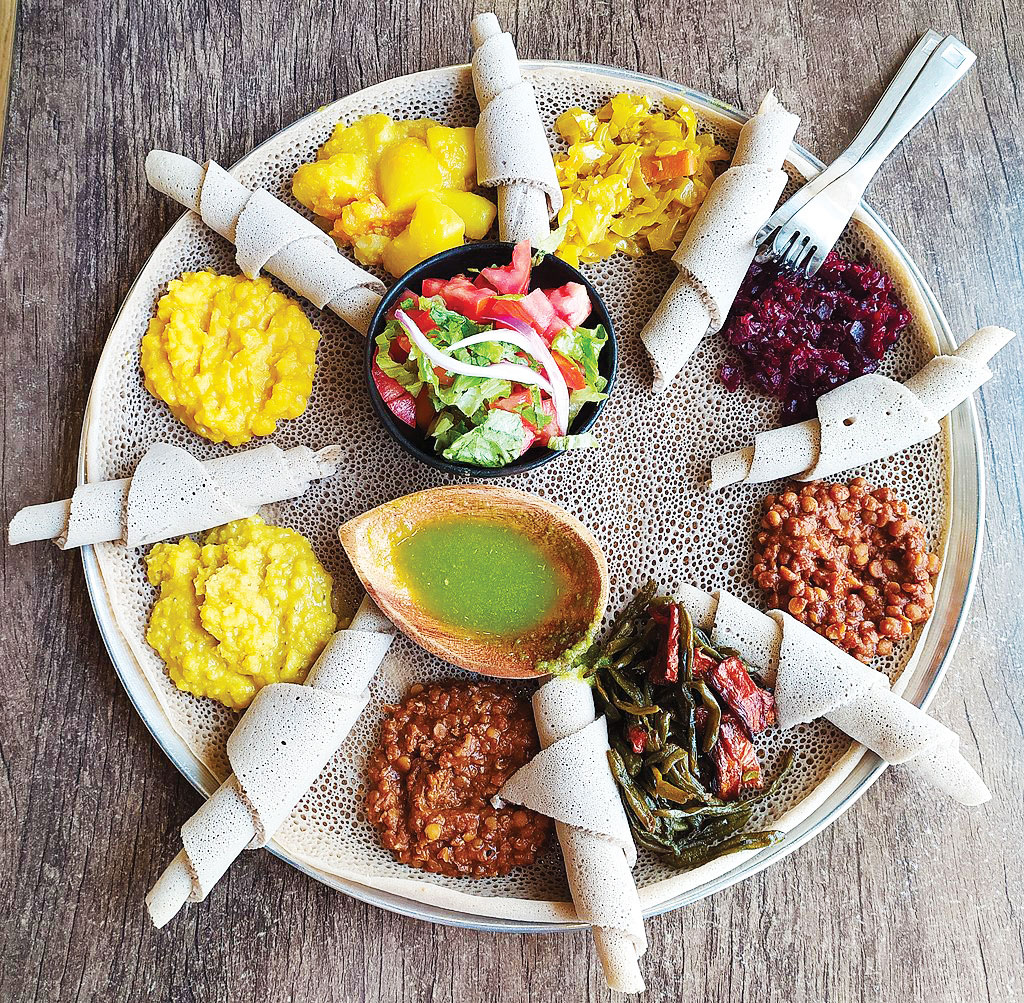Ethiopian Teff Flatbread: Injera
by Shannon Joyner, Garden Companion Editor
 My first experience with Ethiopian food
was at a restaurant in Portland, OR. I
was a student at the time, and sitting
on cushions with friends around the low table
as the server brought a platter covered with a
giant, spongy flatbread called injera, topped
with savory little mounds of different Ethiopian
specialties seemed the height of sophistication—
and certainly a treat, contrasting strongly with
the cheap, highly processed institutional food
served in our cafeteria. No utensils were used,
just our clean fingers, ripping a bit of warm
bread off from the edge, and using it to scoop
up morsels of braised greens, stewed chicken,
and spicy lentils from the center of the platter.
Hilarity ensued as we attempted to figure out
how to pick up a very slippery whole hardboiled
egg in a savory red sauce. Everything
was delicious. Ethiopian food is similar to
Indian curries in that it falls into the same
"saucy-spicy-lots of vegetables" category, but
the flavors are really unique, and I have yet to
replicate them successfully at home. The bread,
however, I've had more luck with. At many
restaurants, injera is made with wheat flour,
as it's cheaper and easier to source than teff
in the U.S., although with gluten-free grains
gaining popularity here, it's now easier to buy
teff flour than it was 10 years ago. Teff provides
a uniquely delicious flavor, ferments rapidly
to give the perfect spongy texture, and has a
nutritional profile—high in protein, iron, and
calcium, and with a low glycemic index—that
makes it worth seeking it out (if you can't find
it, though, you can try sorghum or buckwheat
flour, too). There are many injera recipes online,
with varying degrees of complexity. Some use a
starter, and a batter, and a sort of cooked teff
roux called absit as an emulsifier. Others use
only teff flour and water with a leavener to make
an unfermented batter like regular pancakes. I
found this one (paraphrased below), which combines a bit of fermentation and a bit
of leavening, to give a nice flavor and texture
without an overly complex preparation. Injera
is delicious served with Misr Wat (Ethiopian
spiced red lentils), or can be
used like any other flatbread or wrap, with any
fillings or toppings you like. My first experience with Ethiopian food
was at a restaurant in Portland, OR. I
was a student at the time, and sitting
on cushions with friends around the low table
as the server brought a platter covered with a
giant, spongy flatbread called injera, topped
with savory little mounds of different Ethiopian
specialties seemed the height of sophistication—
and certainly a treat, contrasting strongly with
the cheap, highly processed institutional food
served in our cafeteria. No utensils were used,
just our clean fingers, ripping a bit of warm
bread off from the edge, and using it to scoop
up morsels of braised greens, stewed chicken,
and spicy lentils from the center of the platter.
Hilarity ensued as we attempted to figure out
how to pick up a very slippery whole hardboiled
egg in a savory red sauce. Everything
was delicious. Ethiopian food is similar to
Indian curries in that it falls into the same
"saucy-spicy-lots of vegetables" category, but
the flavors are really unique, and I have yet to
replicate them successfully at home. The bread,
however, I've had more luck with. At many
restaurants, injera is made with wheat flour,
as it's cheaper and easier to source than teff
in the U.S., although with gluten-free grains
gaining popularity here, it's now easier to buy
teff flour than it was 10 years ago. Teff provides
a uniquely delicious flavor, ferments rapidly
to give the perfect spongy texture, and has a
nutritional profile—high in protein, iron, and
calcium, and with a low glycemic index—that
makes it worth seeking it out (if you can't find
it, though, you can try sorghum or buckwheat
flour, too). There are many injera recipes online,
with varying degrees of complexity. Some use a
starter, and a batter, and a sort of cooked teff
roux called absit as an emulsifier. Others use
only teff flour and water with a leavener to make
an unfermented batter like regular pancakes. I
found this one (paraphrased below), which combines a bit of fermentation and a bit
of leavening, to give a nice flavor and texture
without an overly complex preparation. Injera
is delicious served with Misr Wat (Ethiopian
spiced red lentils), or can be
used like any other flatbread or wrap, with any
fillings or toppings you like.
Ingredients (~4 servings)
2 cups teff flour (I use Bob's Red Mill)
4 cups water, divided
3/4 tsp salt
1/2 tsp baking soda
1/4 cup olive oil or ghee
Place the teff flour in a glass or ceramic bowl,
add 31/2 cups of room-temperature water, and
stir well to combine. Cover the bowl with a tea
towel, and leave the mixture on the countertop
to ferment for 2 days, undisturbed (if you have
a cold kitchen, you can put it in your oven with
the light turned on (just don't forget it's in there
and accidentally cook your starter!) The mixture
should be start bubbling, and smell sour/fresh.
After a minimum of 48 hours of fermentation,
the teff should sink to the bottom of the bowl,
with a layer of foamy liquid on top. Do not stir
the mixture, but carefully pour off all the foam
and liquid, leaving the teff solids in the bottom
of the bowl. Gradually add about 1/2 cup of fresh
room-temperature water to the solids, and stir
to make a thin batter, similar in consistency to
crepe batter. Stir in salt and baking soda.
Generously grease a pre-heated 12-inch cast
iron skillet. Pour in enough batter to cover
the bottom of the skillet to form a flatbread of
roughly 1/4 inch thick. Cover with a lid, and cook
on medium heat for 3-5 minutes, until the top of
the injera is dry (don't flip it over), then use a
spatula to transfer the flatbread to a warm plate.
Repeat until all the batter is used up. Enjoy!
♥
top | Newsletter Home |Table of Contents| Archive

|


 My first experience with Ethiopian food
was at a restaurant in Portland, OR. I
was a student at the time, and sitting
on cushions with friends around the low table
as the server brought a platter covered with a
giant, spongy flatbread called injera, topped
with savory little mounds of different Ethiopian
specialties seemed the height of sophistication—
and certainly a treat, contrasting strongly with
the cheap, highly processed institutional food
served in our cafeteria. No utensils were used,
just our clean fingers, ripping a bit of warm
bread off from the edge, and using it to scoop
up morsels of braised greens, stewed chicken,
and spicy lentils from the center of the platter.
Hilarity ensued as we attempted to figure out
how to pick up a very slippery whole hardboiled
egg in a savory red sauce. Everything
was delicious. Ethiopian food is similar to
Indian curries in that it falls into the same
"saucy-spicy-lots of vegetables" category, but
the flavors are really unique, and I have yet to
replicate them successfully at home. The bread,
however, I've had more luck with. At many
restaurants, injera is made with wheat flour,
as it's cheaper and easier to source than teff
in the U.S., although with gluten-free grains
gaining popularity here, it's now easier to buy
teff flour than it was 10 years ago. Teff provides
a uniquely delicious flavor, ferments rapidly
to give the perfect spongy texture, and has a
nutritional profile—high in protein, iron, and
calcium, and with a low glycemic index—that
makes it worth seeking it out (if you can't find
it, though, you can try sorghum or buckwheat
flour, too). There are many injera recipes online,
with varying degrees of complexity. Some use a
starter, and a batter, and a sort of cooked teff
roux called absit as an emulsifier. Others use
only teff flour and water with a leavener to make
an unfermented batter like regular pancakes. I
found
My first experience with Ethiopian food
was at a restaurant in Portland, OR. I
was a student at the time, and sitting
on cushions with friends around the low table
as the server brought a platter covered with a
giant, spongy flatbread called injera, topped
with savory little mounds of different Ethiopian
specialties seemed the height of sophistication—
and certainly a treat, contrasting strongly with
the cheap, highly processed institutional food
served in our cafeteria. No utensils were used,
just our clean fingers, ripping a bit of warm
bread off from the edge, and using it to scoop
up morsels of braised greens, stewed chicken,
and spicy lentils from the center of the platter.
Hilarity ensued as we attempted to figure out
how to pick up a very slippery whole hardboiled
egg in a savory red sauce. Everything
was delicious. Ethiopian food is similar to
Indian curries in that it falls into the same
"saucy-spicy-lots of vegetables" category, but
the flavors are really unique, and I have yet to
replicate them successfully at home. The bread,
however, I've had more luck with. At many
restaurants, injera is made with wheat flour,
as it's cheaper and easier to source than teff
in the U.S., although with gluten-free grains
gaining popularity here, it's now easier to buy
teff flour than it was 10 years ago. Teff provides
a uniquely delicious flavor, ferments rapidly
to give the perfect spongy texture, and has a
nutritional profile—high in protein, iron, and
calcium, and with a low glycemic index—that
makes it worth seeking it out (if you can't find
it, though, you can try sorghum or buckwheat
flour, too). There are many injera recipes online,
with varying degrees of complexity. Some use a
starter, and a batter, and a sort of cooked teff
roux called absit as an emulsifier. Others use
only teff flour and water with a leavener to make
an unfermented batter like regular pancakes. I
found 